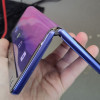Ears-On with Kyocera's Tissue Conduction Phone
May 7, 2012, 10:15 PM by Rich Brome @richbrome
updated May 8, 2012, 12:46 AM

Kyocera is demonstrating a new speaker technology at CTIA that they call tissue conduction, using a special prototype phone. We spent some time with it. Read on for our impressions.
Kyocera is a pretty decent-size company, with divisions spanning all kinds of industries. They make solar panels, lenses, dental equipment... all kinds of things. One of their specialties, though, is ceramics. Not dinner plates, mind you, but some of the most advanced, exotic materials on the planet. Kyocera excels at finding new uses for these specialty ceramics. Their web site lists almost 50 different categories of industry where their ceramics are used.
Kyocera's newest use for their special ceramics is in speakers. Their new ceramic transducers are essentially a whole new kind of speaker, and Kyocera is demonstrating this technology in a concept phone here at CTIA in New Orleans. (This isn't an actual phone coming to market; just a one-off prototype for demo purposes.) We had a chance to try it out.
The first thing you'll notice is that the phone has no speaker grille. The sound is transmitted right through the surface of the phone. This allows phone designers to create phones with even simpler, cleaner designs, with lines and curves unbroken by any unsightly holes, gaps, or grilles.
I held it near my ear, and was impressed with the clarity of the sound. But pressing it to your ear, you get the full benefit of the tissue-conduction effect, and it sounds pretty great.
I thought it might be like the bone-conduction technology a few companies were peddling years ago, but it's not quite like that. There's no part of the phone you can press against your skull to hear really well. Pressing the top of the phone to you skull behind your ear - you can hear the sound with some clarity, but not enough volume.
But the phone is designed to be held to your ear, and when you do that, it sounds noticeably better than most current phones. It's the combination of sound coming from the surface - plus the sound being conducted through the tissue of your ear - that combines to make it sound so good.
Bottom line: it works. You can hear callers very clearly even with background noise on your end, and you can tell that it's not just because the phone is loud.
Kyocera plans to have the technology in a commercial phone in Japan this year, and a phone in the US later on, perhaps next year. We're looking forward to seeing this tech in real phones in the US.
Comments
No messages





 TCL's New Foldable Concept Swings Both Ways
TCL's New Foldable Concept Swings Both Ways
 SoundCore Debuts new Space Series
SoundCore Debuts new Space Series
 Hands On with Xplora Kids Smartwatches
Hands On with Xplora Kids Smartwatches
 TCL's Newest Concept Phone has a Matte Screen
TCL's Newest Concept Phone has a Matte Screen
 Hands On with Teams-Certified Bluetooth Earbuds
Hands On with Teams-Certified Bluetooth Earbuds



